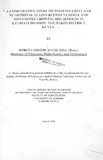| dc.contributor.author | David, Dorcus M | |
| dc.date.accessioned | 2013-05-08T09:51:29Z | |
| dc.date.available | 2013-05-08T09:51:29Z | |
| dc.date.issued | 2002-08 | |
| dc.identifier.citation | David, D.M(2002).A comparative study on food security and nutritional status between coffee and non-coffee growing households in Kathiani Division"Machakos District Kenya. | en |
| dc.identifier.uri | http://erepository.uonbi.ac.ke:8080/xmlui/handle/123456789/20241 | |
| dc.description | Msc-Thesis | en |
| dc.description.abstract | A comparative study on food security and nutritional status of coffee and non-coffee
growing households was carried out in Iveti Location of Kathiani Division, Machakos
District, in the months of September, October and November, 2000.
The objective of the study was to determine the difference in household food security and
nutritional status of children aged (6-59) months in coffee growing and non - coffee
growing households in the location.
A sample size of 350 households was used. The study district, division and location were
purposively selected. Random sampling was done at the sub-location to select the villages.
The sampling unit was the household. The households were systematically sampled and
equal number of coffee and non-coffee growing households drawn. Data were collected
using a structured questionnaire, anthropometric measurements and focus group
discussions.
About three quarters (76 %) of all the households visited did not meet 80% of their daily
calorie requirements. Only 7.4% of the households were able to meet their calorie
requirement. More households (55%) not growing coffee than households growing coffee
(45%) were found to be food insecure.
The prevalence in the study area was high. Moderate and severe stunting were 29% and
26% respectively. The figure for severe stunting is too high indicating long-term
cumulative effects of inadequate nutrition and health for most of the households.
Immediate attention in implementing the recommendations, would, therefore, be
necessary. Moderate and severe underweight were 26% and 9.1% respectively, while
moderate and severe wasting 4.7% and 0.3%, respectively. Levels of severe underweight
and severe stunting were higher than the national and provincial figures.
The level of malnutrition was generally higher among households without coffee than
those growing coffee except for severe stunting where households growing coffee and
those without coffee reported 29% and 26% respectively Further, households growing
coffee did not report any case of severe wasting while some households without coffee did
(0.3%).
It was concluded that household food security is worsened by large household sizes, low
levels of education, small land size holdings and other socio-demographic and socioeconomic
characteristics. It was also concluded that household food security and
nutritional status could be improved by growing coffee.
It is suggested that coffee farming should be promoted in households without coffee. It is
also recommended that income-generating activities should be initiated. Further, keeping
of livestock should be encouraged in both types of households. | en |
| dc.description.sponsorship | University of Nairobi | en |
| dc.language.iso | en | en |
| dc.subject | Food security | en |
| dc.subject | Nutritional status | en |
| dc.subject | Coffe and non-coffee growing households | en |
| dc.subject | Kathiani Division | en |
| dc.subject | Machakos District | en |
| dc.subject | Kenya | en |
| dc.title | A comparative study on food security and nutritional status between coffee and non-coffee growing households in Kathiani Division"Machakos District Kenya. | en |
| dc.type | Thesis | en |
| local.publisher | Department of Food Science, Nutrition and Technology, University of Nairobi | en |

